Hello everyone, I’m Michael Zhang—a Chinese traveler who has explored five continents and continues to pursue journeys rich in cultural depth. Over the years, I’ve come to realize that the most unforgettable places aren’t necessarily those popular for photos, but those where culture, history, and spiritual meaning run deep. Today, I’d like to introduce you to one of the most culturally profound destinations in China: Mount Emei. Home to ancient Buddhist heritage, dramatic mountain landscapes, and serene temples, it’s a place where history meets nature. Whether you’re a history buff, a photography lover, or a soul-searching traveler, Mount Emei deserves a thoughtful visit.
Summary
Mount Emei Overview
Mount Emei rises sharply from the Emei Plain, stretching over 105 kilometers from north to south. The main peaks include Da E Mountain, Er E Mountain, San E Mountain, and Si E Mountain, with Da E Mountain forming the core scenic area. It covers 154 square kilometers, and its highest peak, Wanfo Summit, reaches an elevation of 3,099 meters. The mountain is a reservoir of rich cultural significance. Buddhism, Taoism, martial arts, and tea culture have all flourished here, and numerous historical figures have left their poetic marks across its slopes. In 1996, the majority of Mount Emei’s cultural relics were inscribed in the UNESCO World Heritage List. Recognized as one of China’s Four Sacred Buddhist Mountains, Mount Emei is often called the most beautiful of them all and has been designated as a national 5A-level tourist attraction.
- Address: Mount Emei Scenic Area, Leshan, Sichuan (Apple Maps / Amap)
- Opening Hours:
- May 1 – October 7: 6:00 AM – 6:30 PM
- October 8 – April 30: 7:00 AM – 5:30 PM
- Suggested Visit Duration: 6 hours (a 2-day visit is highly recommended)
- Best Seasons to Visit: March to May, and September to November
- Ticket Prices:
- Peak Season (January 16 – December 14): 160 CNY
- Off Season (December 15 – January 15): 110 CNY
- Ticket Purchase: Trip.com Discounts
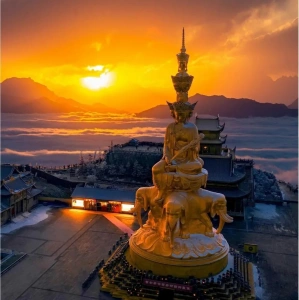
Mount Emei Map
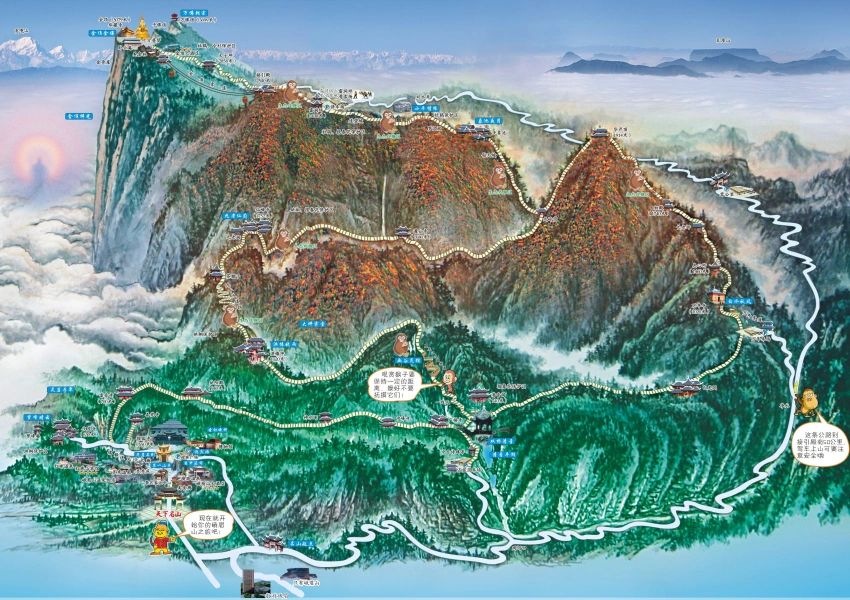
Why You Should Visit Mount Emei
Breathtaking Natural Scenery Unique to Mount Emei
As one of China’s Four Sacred Buddhist Mountains, Mount Emei lies in the southwestern section of the Sichuan Basin. It is a dramatic fault-block mountain known for its massive elevation changes. The landscapes shift drastically from lush, stream-filled lowlands to cloud-filled alpine heights. Visitors often experience the saying, “One mountain, four seasons; ten miles, different skies,” firsthand. Rich in biodiversity, the mountain also serves as an important ecological conservation area.
Profound Buddhist Heritage
Mount Emei is the sacred domain of Samantabhadra Bodhisattva. With nearly 2,000 years of Buddhist development, the mountain is home to numerous temples such as Baoguo Temple, Wannian Temple, Qingyin Pavilion, and the Huazang Temple at the Golden Summit. These sites offer architectural beauty, ancient scriptures, and sacred relics that serve as living expressions of Buddhist history. Even more impressive are the mountain’s four spiritual phenomena—sunrise, sea of clouds, Buddha’s light, and divine lanterns—which form a stunning blend of natural spectacle and religious symbolism.
Unexpected Encounters with Monkeys
The monkeys of Mount Emei have quite a reputation. Bold and curious, they often interact directly with tourists—sometimes stealing food or playfully causing mischief. While this might be a surprise for first-time visitors, it’s a one-of-a-kind experience that adds a playful edge to a spiritually profound destination.
Top Things to Do in Mount Emei
Main Attractions
Golden Summit
The Golden Summit sits at the highest point of Mount Emei and represents the ultimate pilgrimage destination for Buddhist devotees. It is also the best place to witness the mountain’s famed “Three Wonders”—a sea of clouds, sunrise, and the mystical Buddha’s light. The Ten Directions Samantabhadra Bodhisattva statue, standing 48 meters tall, can be viewed from all sides and is currently the tallest golden Buddha in the world. According to legend, touching the statue grants ten blessings, and many visitors make the journey specifically to pray and make a wish. Touch the statue for good fortune—it’s said to be remarkably effective! Keep in mind that temperatures at the summit vary drastically; a down jacket and sunscreen are essential gear.
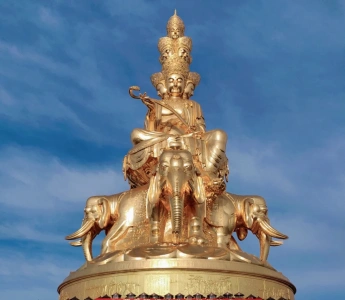
Wannian Temple
Wannian Temple is one of the oldest and most iconic temples on Mount Emei, originally built during the Eastern Jin Dynasty. It is renowned for its bronze statue of Samantabhadra Bodhisattva riding a six-tusked white elephant. The temple is often filled with incense and spiritual seekers, serving as a core location for experiencing the essence of Mount Emei’s Buddhist culture. The incense ticket costs 10 CNY. Visiting in the early morning offers a quieter and more meditative experience.
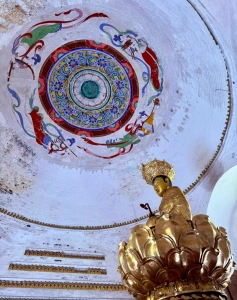
Qingyin Pavilion
Qingyin Pavilion, often praised as “the most beautiful water landscape in Mount Emei,” is a paradise for photographers. Here, mountains and water blend harmoniously, and twin bridges span over two converging streams, resembling a scene straight from a Chinese landscape painting. Not only is this a popular photo spot, but it also provides a peaceful sanctuary for reflection. Bring an empty bottle—spring water here is fresh and drinkable straight from the source.
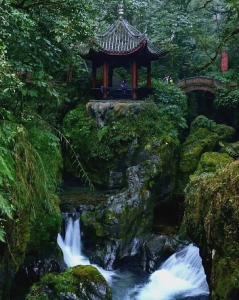
Ecological Monkey Zone
This area is the wildest and most unpredictable part of Mount Emei, offering the closest encounters with the region’s famed monkeys. These intelligent and curious animals have no fear of tourists and are particularly drawn to snacks and phones. A word of caution: keep your belongings—especially food and electronics—safely stowed!
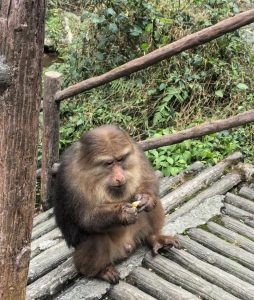
Fuhu Temple
Located at the foot of Mount Emei, Fuhu Temple often serves as the first or last stop for travelers. Nestled in serene surroundings and traditional architecture, the temple offers a tranquil space for meditation or quiet rest. It’s a wonderful place to start or conclude your spiritual journey into the mountain.
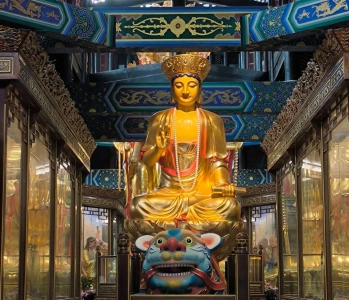
Mount Emei Ticket Guide
Ticket Prices for Mount Emei
- Adults:
- Peak Season (January 16 – December 14): 160 CNY
- Off Season (December 15 – January 15): 110 CNY
- Children/Students: Height between 1.2m (excluding) and 1.5m (including), or ages 6 (excluding) to 18 (excluding).
- Peak Season: 80 CNY
- Off Season: 55 CNY
- Free Entry: Children under 6 years old, under 1.2m in height, or seniors aged 65 and above.
Where to Buy Tickets
- Online: Official WeChat public account and third-party platforms.
- Ticket Purchase: Trip.com Discounts
- On-site: Physical ticket counters. During peak season, online booking is strongly recommended as tickets often sell out.
Recommended Routes for Ascending Mount Emei
Mount Emei can be accessed by hiring a private car or hiking, depending on your energy and time. For travelers with kids or elderly companions, self-driving or taking sightseeing shuttles is advisable. For more adventurous visitors, hiking routes offer a rewarding challenge.
- Private Car Route: Entrance – Zero Kilometer Parking – Leidongping – Jieyin Hall (30-minute walk) – Cable car or hike to Golden Summit – Final 15-minute walk to summit
- Sightseeing Shuttle Route: Entrance – Leidongping (2 hours) – Jieyin Hall – Cable car or hike to summit – Final walk to Golden Summit
- Hiking Route One (27 KM, 8–20 hours): Baoguo Temple – Fuhu Temple – Qingyin Pavilion – Monkey Zone – Hongchunping – 99 Bends – Xianfeng Temple – Jiulinggang – Elephant Bathing Pool – Leidongping (2 hours) – Golden Summit
- Hiking Route Two (24 KM, 6–15 hours): Entrance – Qingyin Pavilion – Wannian Temple – Xixinsuo – Zhanglaoping – Huayan Peak – Jiulinggang – Elephant Bathing Pool – Leidongping (2 hours) – Golden Summit
Where to Store Luggage on Mount Emei
Many visitors travel to Mount Emei with luggage or come directly from train stations. The following are convenient luggage storage options for climbers.
- Mount Emei Bus Station (Baoguo Temple): This is also the transfer point for shuttle buses to Leidongping and a landmark along hiking routes. Storage lockers cost 1 CNY/hour, capped at 12 CNY/day, with a three-day limit. Note: only small suitcases and backpacks can be stored here.
- Mount Emei Railway Station offers two storage options; the China Post location is more affordable and both allow overnight storage.
- Official Storage Point: Right-hand side after exiting the high-speed rail station. Standard rates: 20 CNY/item for suitcases, 10 CNY/item for backpacks. After 5 PM, an extra 10 CNY/item is charged.
- China Post: Turn left after exiting the station; it’s about 20 meters away. Storage costs around 10 CNY/item for both suitcases and backpacks. After 5 PM, add 10 CNY/item.
Recommended Vegetarian Food Around Mount Emei
Sampling vegetarian meals on Mount Emei is a must. Several temples serve affordable and flavorful Buddhist meals, usually available at lunch and sometimes at breakfast and dinner. Compared to commercial restaurants that typically charge 70–80 CNY per person, these meals offer excellent value and an authentic experience.
Huazang Temple at Golden Summit – Yangyi Shanfang
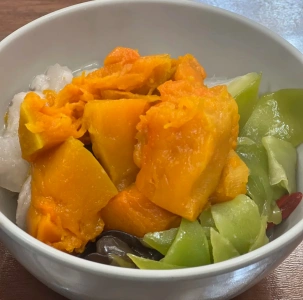
- Why go: Dishes are prepared using fresh vegetables, tofu, mushrooms, and other plant-based ingredients, skillfully crafted to resemble meat-based dishes.
- Hours: 6:00 AM, 11:30 AM, 6:00 PM
- Average Price: 66 CNY
Dafo Zen Monastery
- Why go: A wide variety of dishes made from fresh ingredients, cooked lightly to preserve original flavors. A top choice for healthy dining.
- Hours: 7:10–7:40 AM, 11:30 AM–12:00 PM, 5:30–6:30 PM
- Average Price: 20 CNY
Leidongping
- Why go: Focused on vegetarian cuisine sourced locally, meals are fresh, healthy, and eco-friendly.
- Hours:
- Average Price: 30 CNY
Wannian Temple
- Why go: Enjoy stir-fried seasonal greens, savory bean curd, and sweet rice with hearty vegetable soup—a humble yet fulfilling meal.
- Hours: 11:30 AM
- Average Price: 20 CNY
Baoguo Temple
- Why go: Try refreshing black fungus salad, braised tofu, and sweet corn porridge. Every dish is nourishing and thoughtfully prepared.
- Hours: 7:00 AM, 11:30 AM, 6:30 PM
- Average Price: Breakfast 10 CNY, handmade buns 2 CNY, lunch 15 CNY, dinner 15 CNY
Fuhu Temple
- Why go: Delicate vegetarian meatballs, forest mushroom soup, and simple yet flavorful noodles—all carefully made and full of mountain spirit.
- Hours: 12:00 PM
- Average Price: 30 CNY
Recommended Hotels Near Golden Summit and Leidongping in Mount Emei
There are hotels right at the top of Mount Emei, which is ideal if you plan to watch the sunrise. Staying near the Golden Summit is convenient, but keep in mind that reaching these hotels requires hiking, so it’s not suitable for travelers with large suitcases. If you’re carrying luggage, it’s better to stay around Leidongping, where shuttle buses are available. Prices are also generally lower. However, if you’re staying at Leidongping, be sure to wake up two hours early to hike up for the sunrise. Below are some hotel recommendations.
Jinding Villa
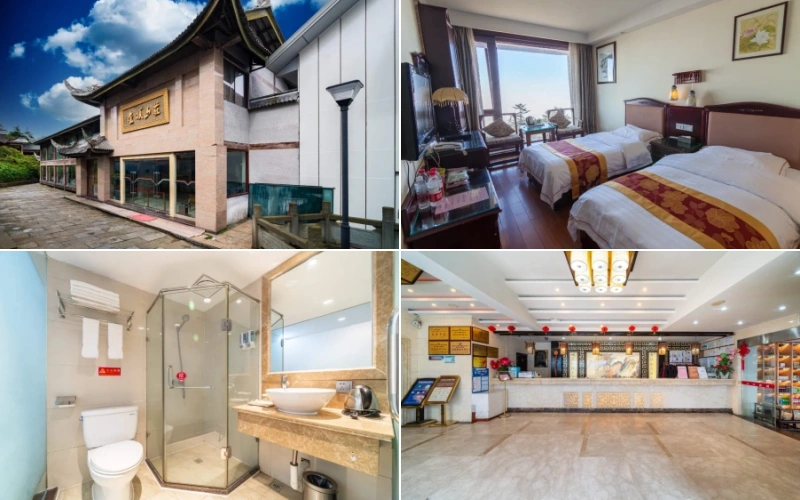
- Location: 5-minute walk from Mount Emei’s Golden Summit
- Price per night: from 580 CNY
- Check Rates: Trip.com Specials
- Rating: Trip 8.8
This is the hotel closest to the Golden Summit. The location is unbeatable, and the view from the rooms is excellent. It’s a convenient option for those planning to catch the sunrise without waking up too early.
The hotel is relatively old, and facilities are outdated. Still, it’s the most affordable option near the summit. Hygiene is generally decent, and given its unique location, the value for money is quite good.
Jinding Hotel
.webp)
- Location: 5-minute walk from Mount Emei’s Golden Summit
- Price per night: from 623 CNY
- Check Rates: Trip.com Specials
- Rating: Trip 7.9
The hotel’s location is excellent—it’s just a few steps down from the cable car station. All rooms have windows with scenic views. There are two buildings: Woyun Tower and Yuexia Tower. Yuexia Tower is newer and more expensive. If you’re aiming for that, you might want to consider Jinding Xinxin Hotel instead, which is similarly priced but newer.
Facilities are somewhat old, and the rooms are small, though clean and functional. The hotel offers four bottles of mineral water, which is generous given the mountaintop location. However, the soundproofing is quite poor.
Jinding Xinxin Hotel
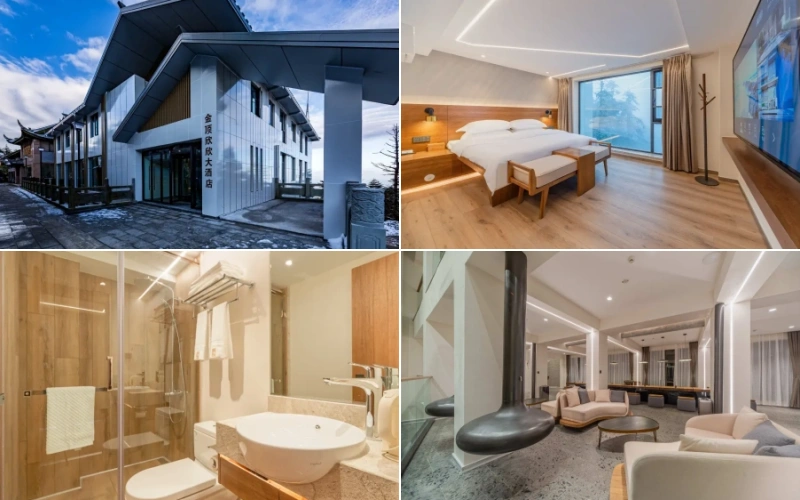
- Location: 5-minute walk from Mount Emei’s Golden Summit
- Price per night: from 880 CNY
- Check Rates: Trip.com Specials
- Rating: Trip 9.3
This is one of the newest hotels near the summit. It’s quite impressive considering the altitude. From the rooms, you can enjoy views of the surrounding pine forest, creating a truly relaxing atmosphere.
Rooms are small but very clean. The hotel offers free Buddhist scripture copying and tea tasting in the afternoon. Despite its compact size, it provides many thoughtful touches—clean bedding, a subtle pinewood scent, in-room floor heating, and an oxygen machine.
Qixiangju Hostel
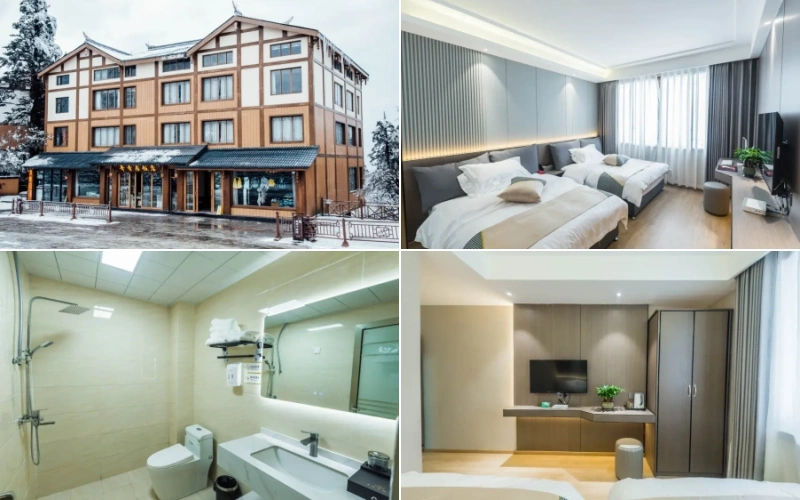
- Location: 5-minute walk from Leidongping parking area
- Price per night: from 428 CNY
- Check Rates: Trip.com Specials
- Rating: Trip 9.0
There aren’t many hotels in Leidongping, but this one is easy to find. It’s right next to the shuttle drop-off point.
Rooms are spacious with clean bedding and good toiletries. However, soundproofing is poor—you can hear most noises from the hallway or outside. Still, the value is excellent.
Xinlongmen Boutique Hotel

- Location: 5-minute walk from Leidongping parking area
- Price per night: from 428 CNY
- Check Rates: Trip.com Specials
- Rating: Trip 8.9
This hotel is located right where the shuttle buses drop off passengers, making it extremely convenient for both uphill and downhill travel. There are several restaurants nearby, and it’s close to the ski area.
Rooms are small, and suitcases can only be opened on the floor. Bedding is very clean—even picky guests will find nothing to complain about. With underfloor heating, it’s comfortable all year round.
How to Get to Mount Emei from Chengdu
The best way to travel from downtown Chengdu to Mount Emei is by train—it offers the best overall experience.
- Departing from downtown Chengdu: Go to either Chengdu East Station or Chengdu South Station and take a train to Emeishan Station (note: Emeishan Station, not Emei Station). Follow the signs or the crowd to reach the Mount Emei scenic area.
- Route: Chengdudong ↔ Emeishan, Chengdunan ↔ Emeishan
- Train Booking: Click to Book
- From Chengdu Tianfu Airport: Take Metro Line 18 to Chengdu South Station, then take a train to Emeishan Station. Follow the signs or the crowd to reach the scenic area.
- Route: Chengdudong ↔ Emeishan
- Train Booking: Click to Book
- From Chengdu Shuangliu Airport: Depart from the high-speed train station at the airport and take a train to Emeishan Station. Follow the signs or the crowd to reach the Mount Emei scenic area.
- Route: Shuangliu Airport ↔ Emeishan
- Train Booking: Click to Book
How to Get to Mount Emei from Leshan City
The fastest and most recommended way to get from Leshan city to Mount Emei is by high-speed train (cost: 10 CNY, duration: 10 minutes). For a cheaper option, you can take buses 601 or 602 (5 CNY, around 1 hour). Taking a taxi directly costs around 100 CNY, but you can consider ride-sharing (15 CNY), which is commonly available near the train station.
High-Speed Train
Taking the high-speed train is both the easiest and most affordable option. Depart from Leshan Station and arrive at Emeishan Station (note: Emeishan Station, not Emei Station) in just 15 minutes. After exiting, follow the signs or the crowd to reach the Mount Emei scenic area.
- Route: Leshan ↔ Emeishan
- Train Booking: Click to Book
Public Bus
If you prefer to take the bus, you can hop on routes 601 or 602 from downtown Leshan. The fare is 5 CNY, and the trip takes about one hour.
FAQ
Unfortunately, no. Mount Emei has many staircases that cannot be avoided.

 English (Malaysia)
English (Malaysia)
 English (US)
English (US)  English (Hong Kong)
English (Hong Kong)  English (Singapore)
English (Singapore)  繁體中文
繁體中文 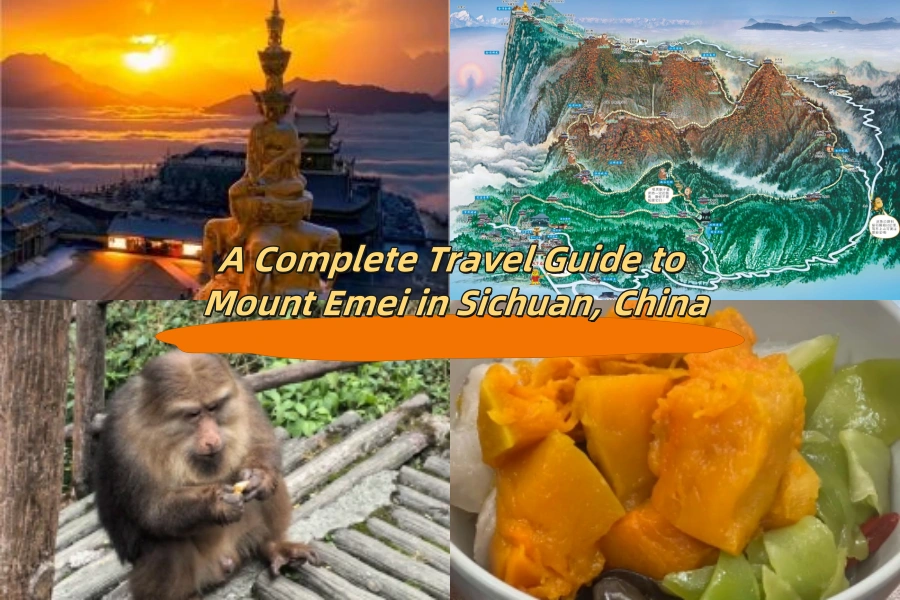
Comment (0)